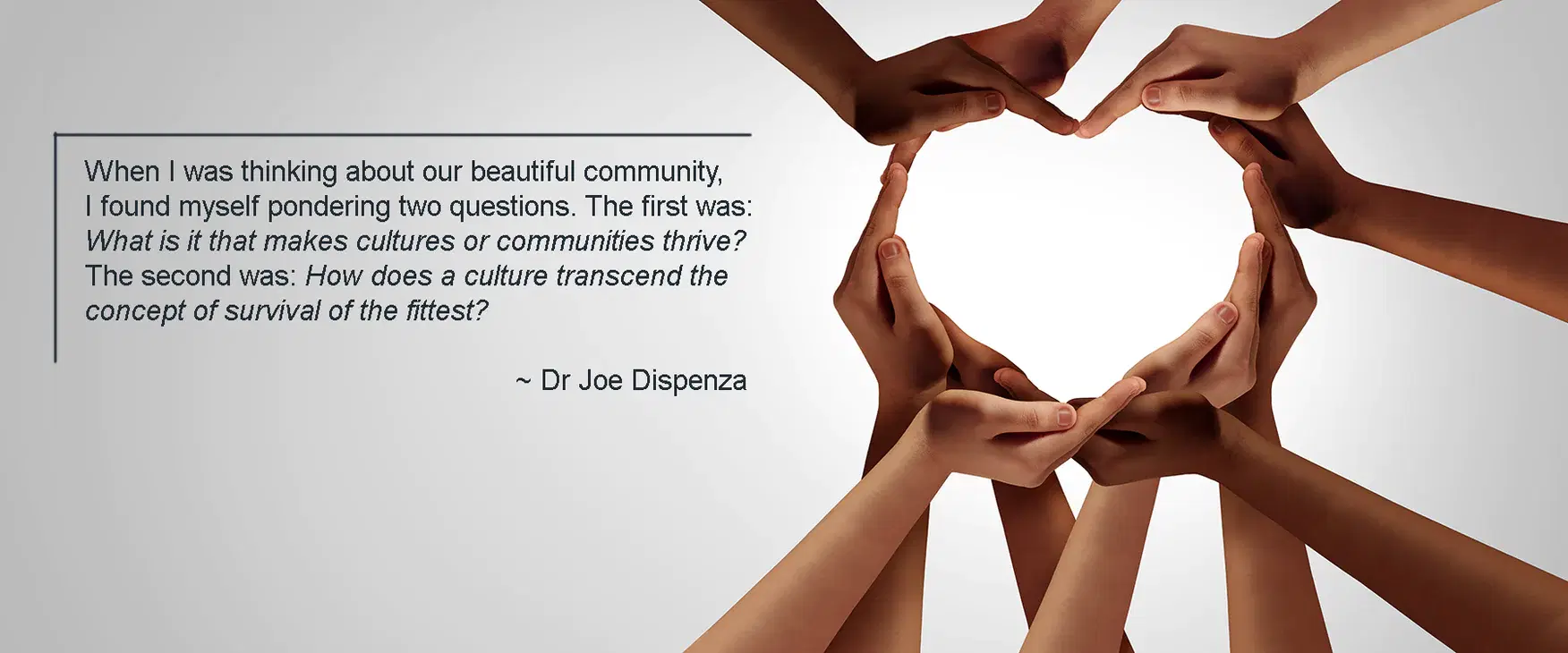Community, Culture, and Care:
Part I
Dr Joe Dispenza | 29 January 2021
Recently, when I was thinking about our beautiful community, I found myself pondering two questions. The first was: What is it that makes cultures or communities thrive? The second was: How does a culture transcend the concept of survival of the fittest? To answer these questions, I first had to ask the question: What is culture? One of the dictionary definitions as it pertains to these questions tells us that culture is “the quality in a person or society that arises from a concern for what is regarded as excellent in arts, letters, manners, scholarly pursuits, etc.”
We could say then that cultures are comprised of specific customs and traditions, unique histories, common folklore, ancient stories made up of allegories designed to teach important morals and values, distinct climates, sustainable foods, functional social structures, impressionable art, and so on. To distill these indigenous aspects into a singular element, it’s clear that cultures are shaped by environments. As an example, an Aboriginal culture in Central Australia will be very different than a culture in the Swiss Alps. Why? Because they exist in vastly different environments.
Cultures are important because they are the bridge between our universal, human traits and our individual traits. Our universal traits as human beings are framed by sharing the same structure and function. For example, we all stand on two feet, we sleep at night, we grab tools such as sticks in the same way, we smile when we're happy, frown when we’re sad, and so on. Because we as humans share these same biological structures and functions, there is a universality in the way in which we interact with each other.
While the brain is the universal structure, on the individual level each of our brains are wired according to a delicate blend of nature vs. nurture. On the nature side, this refers to the genes we inherit from our forebears. On the nurture side, this means the immediate environment we grew up in, which includes how we’re raised by our families, the education we receive, our friends, our economic situation, our religion, and so forth. While our universal traits are shared by the gross anatomy of our species, our individual traits are based on how we are uniquely shaped by nature and nurture. Another way to think of this is that our hand represents our gross anatomy (meaning we all share similar traits on how it’s shaped and how we use it), but our fingerprints (which represent our individuality) are akin to the way each of our brains are wired.
How Cultures Evolve
Because of different environments, homes are built a certain way according to the climate of that environment, certain foods are more available, people live a certain way, and people adapt to certain ways of surviving in order that individuals in that culture can thrive within the environment. This makes the environment the bridge between our universal traits and our individual traits. We could say then that the culture becomes a kind of record of what allows us to thrive in certain environments. That record is based on past memories, created from the knowledge and experience of our external environments.
In order to change a culture, there have to be people who can begin to see new possibilities to evolve that culture. This requires a clear intention or a vision of the future. Once that person or those people can imagine that new vision, through leading by example and learning the necessary information to adapt to a changing environment, they inspire others to feel the emotions of that new future before it’s made manifest. They do this by inspiring people to rise out of their resting emotional states—out of their conditioned habits of thoughts, beliefs, feelings, and behaviors.
Throughout history, great leaders such as Martin Luther King Jr. or Mahatma Gandhi were able to evolve cultures by inspiring others to feel emotions that they didn’t typically feel day in and day out. That change in energy lifted groups of people to see new possibilities that they could not see when they were living in the same emotional states. They achieved this by seamlessly combining a clear intention of a new future with an elevated emotion—the two things that change an individual’s state of being. That’s because thoughts are the language of the brain and feelings are the language of the body, and how you think and how you feel create your state of being.
When enough people can move into a new state of being, they begin making different choices, doing things differently, caring for one another in new ways, and creating novel experiences; then all of a sudden—the culture evolves itself. That means that the evolution of culture is created from a clear intention and an elevated emotion that arises from our internal environment—instead of the external environment—and that the best way to change a culture is to change, individual by individual, until a critical mass of change is achieved. At that point, everyone is observing everyone else as different, which then becomes the new culture. And since people are a large part of the environment of the culture, when everyone is expressing a new state of being, there’s a new consciousness in that culture.
But what happens when you no longer have a typical environment, such as the times in which we are living? Stay tuned for part II to get an answer to that question.
Read Part ll

Comments